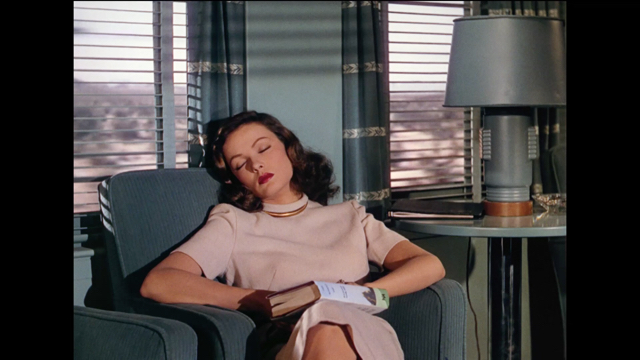A woman is sitting alone in a chair, her elbows propped up on the armrests. She is holding a book in her hands that conceals her face. Its cover reads: “Time Without End.” She could be sitting in the suite of an elegant hotel, if it wasn’t for the American landscape monotonously passing by in the window behind her. The woman is sitting in a “Santa Fe Super Chief” speeding forward, the luxury train of the rich and beautiful of the 1940s. Slowly, she lowers her arms and, with them, the book. We can make out her face. Her eyelids close. The book is resting on her knees. Asleep, she pushes it away—it falls on the floor.
The actual narrative is only slowly revealed in Klaus vom Bruch’s found-footage work Time Without End (1996): the film sequence from the Technicolor film noir Leave Her to Heaven (1945) by John M. Stahl was manipulated by the artist in such a way that the image sequence and its soundtrack, in a continuous loop, are moved along the continuously progressing timeline, frame by frame, that the flow of movement gives way to a staccato.
In the drop of the book, which moves forward image by image, the deconstruction of the narrative motif culminates: the movement now reverses itself, as if the book bounced back from the floor. The image sequence is pushed back again frame by frame until the woman is holding the book in her hands again and her face disappears behind it, while the landscape, perforated by telegraph poles flitting past, continues to pass by endlessly in the background. The loop starts over.
The motif ends with the resting book on the woman’s knees. The loop is reduced to a point, in a way circling within itself: a present continuous time without end, as it were. This pushes further the idea underlying the work of rendering visible the speed of technical developments and their perception. It is certainly no accident that vom Bruch chose a scene taking place on a train as his raw material, leading us as it does in the vicinity of Paul Virilio’s considerations on the connections between the development of (film) techniques, vehicles, and speed. Each specific medium possesses an inherent speed, which in turn influences the perception of the speed. In that way, Klaus vom Bruch’s Time Without End exposes the perception moments and logics of our contemporary speed machines. – Marie-France Rafael
Klaus vom Bruch (b. 1952 in Cologne) studied at the California Institute of the Arts at John Baldessari and Bruce Nauman from 1975 to 1976 and a couple of semesters Philosophy, Art History and Egyptology at the University Cologne until 1981. His first videotapes he produced in 1975.

